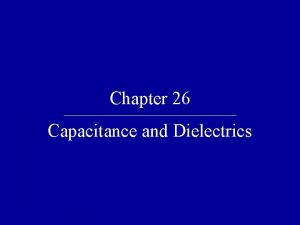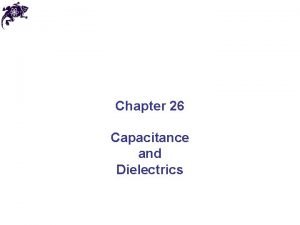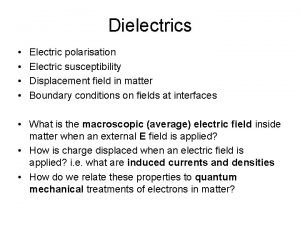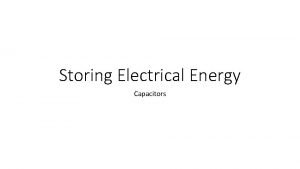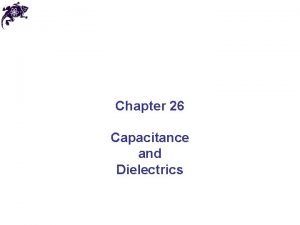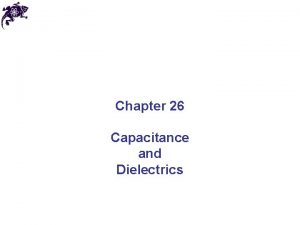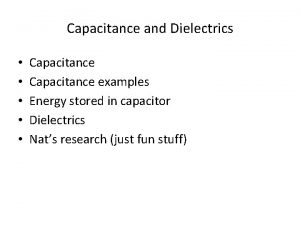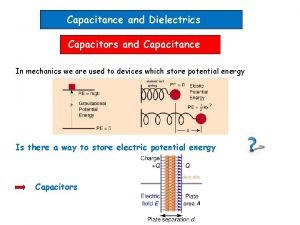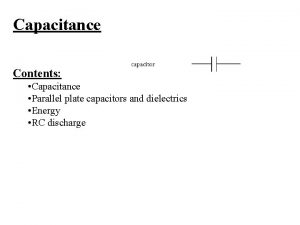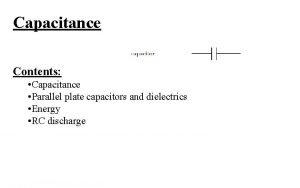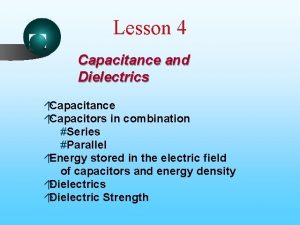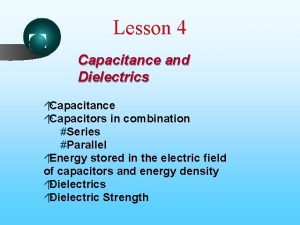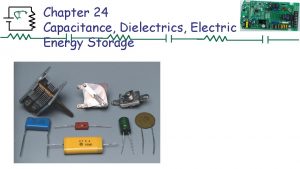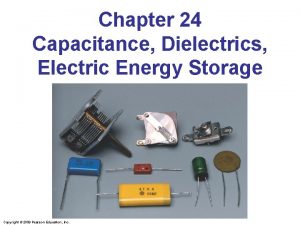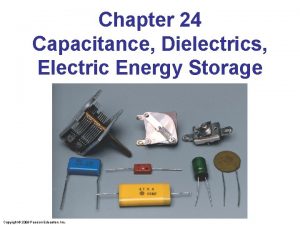Ch 17 Part 2 Capacitance Dielectrics Electric Energy













- Slides: 13

Ch 17 Part 2 Capacitance, Dielectrics, & Electric Energy Storage

Capacitance Devices that can store electric charge are called capacitors. Capacitors consist of 2 conducting plates separated by a small distance containing an insulator. Capacitors are used in electronics, computers, camera flashes, and as protectors of circuits for surges or memory (RAM) of binary code.

Capacitors become quickly charged when a voltage is applied to it in a circuit. One plate will be negatively charged and the other plate will have an equal positive charge. The charge, Q, depends on the potential difference, V, applied to it. Q = CV. C is a proportionality constant called capacitance of the capacitor and is measured in coulombs/volt or farad (F). Common capacitance ranges are from 1 p. F (pico. Farad) to 1µF (micro. Farad) (10 -12 to 10 -6).

Capacitance, C The Capacitance, C, depends on the area of the capacitor plates and the distance of insulated (or air) separation. Recall the permittivity of free space constant has a value of 8. 85 x 10 -12 C 2 /N*m 2

Ex 1 Capacitor calculations (a) Calculate the capacitance of a capacitor whose plates are 20 cm x 3. 0 cm and are separated by a 1. 0 mm air gap. (b) What is the charge on each plate if the capacitor is connected to a 12 -V battery? (c) What is the electric field between the plates?

Solutions (a) The area A = 20 cm x 3. 0 cm = 60. 0 cm 2 = 6. 0 x 10 -3 m 2 so the capacitance, (b) The charge on each plate is Q=CV (c) For a uniform electric field b/t the plates, E=V/d

Storage of Electric Energy A charged capacitor stores energy equal to the work done to charge it. Batteries charge capacitors by removing charge from one plate and putting charge on the other plate. This takes time. The more charge already on a plate, the more work required to add more charge of the same sign. Initially when a capacitor is uncharged, it takes NO WORK to move the first bit of charge over.

Storage of Electric Energy The work needed to move a small amount of charge Δq, when a potential difference, V, is across the plates, is ΔW=VΔq. Voltage increases during the charging process from 0 to its final value Vf. Since the average voltage during this process will be Vf /2 then the total work, W to move all of the charge, Q at once is the energy stored, U, in the capacitor: U=energy=1/2 QV. Since Q=CV, then U=1/2 QV=1/2 CV 2 =1/2 Q 2/C.

Example 2 -Energy storage A camera flash unit stores energy in a 150µF capacitor at 200 V. How much electric energy can be stored?

Example 2 Solution U = energy = ½ CV 2 = Notice how the units work out: recall 1 F=1 C/V and 1 V=1 J/C. If this energy could be released in 1/1000 s the power output would be 3000 W.

Separation anxiety? Though energy is not a substance in a place, it is helpful to think of it as being stored in the electric field between the plates. Recall the electric field b/t 2 parallel plates separated by a small distance is uniform and related to electric potential, V by V=Ed. Also recall capacitance, C

Thinking farther Therefore, energy stored, U in terms of the electric field is found The quantity Ad is the volume between the plates where the electric field E exists. Dividing both sides by the volume, we get the Energy stored is energy / volume or energy density proportional to the square of electric field.

Your turn to Practice Please do Ch 17 Rev p 524 #s 30, 32, 33, 35, 36, 37, 43, 44, & 45
 Capacitance and dielectrics quiz
Capacitance and dielectrics quiz Capacitance and dielectrics
Capacitance and dielectrics Electric displacement
Electric displacement Electric field lines
Electric field lines Energy stored in capacitor
Energy stored in capacitor Energy electric field
Energy electric field Electric potential
Electric potential Electric potential is
Electric potential is A suitable electric pump in an electric circuit is a
A suitable electric pump in an electric circuit is a Chapter 21 electric charge and electric field
Chapter 21 electric charge and electric field Chapter 21 electric charge and electric field
Chapter 21 electric charge and electric field Coulombs units
Coulombs units Dc o/d per item charge
Dc o/d per item charge Electric charges and electric forces lesson outline
Electric charges and electric forces lesson outline
